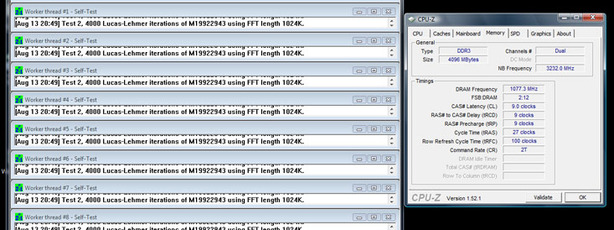Overclocking
Overall overclocking performance was good for the GD65 with the latest (at the time of writing) 1.41 BIOS, however it has to be noted the board does suffer from a more considerable vDroop than we've seen on other boards.It needs extra voltage to compensate and despite enabling the vDroop compensation in the BIOS (which is a must for overclocking), we found a 0.05V drop under load when pushing either a Core i5 or i7 chip heavily. Clearly, the DrMOS MOSFETs are struggling a little.
Pushing for maxmium CPU frequency we hit a stability wall at 190MHz base clock, with a 22x multiplier and 1.45V core voltage, 1.42V VTT, 1.9V PLL and 1.12V PCH voltage. With the i7-870 this yielded 4.18GHz, but with the Core i5-750 that's more limited by multipliers, this could only reach 3.99GHz. Not a huge worry - that's still fast, but we know Lynnfield CPUs are good for 4.2 to 4.4GHz with the right cooling, voltage and motherboard. The MSI did allow the extra single increment in multiplier to 21x, from 20x, for the Core i5-750 when EIST is set to Auto, which is certainly a plus, but then again the Asus board allows two to 22x multiplier.
Aiming for maxmium base clock by dropping the multiplier we saw a much more surprising result though. When chatting to MSI's engineers in Taiwan while I was running the overclock for advice and feedback, they said they'd seen only 210MHz from an i5-750. However, we found our board kept going and hit a 217.5MHz base clock, but suffered a sharp stability drop off above this value. To reach this, we ramped the VTT to 1.48V, but lowered the CPU voltage to 1.4V in order not to cook the poor thing, despite the Cooler Master V8 CPU cooler working admirably.
As for maximum memory performance, we were actually a little let down. While the Asus cruised through 2.3GHz and couldn't quite scrape 2.4GHz with our DIMMs, we could only manage a measly 2,154MHz from 2,200MHz memory at timings higher than what it was rated to do: 9-9-9-27-2T at 1.75V. The MSI GD65 is clearly not the board for those looking to push the extremes and is instead for those more limited by the 10x multiplier in a Core i5-750 CPU. With that in mind, you'll be able to hit around 2,000MHz, on condition you can reach that magic 200MHz base clock.

Power Consumption
Power Consumption for the MSI is notably better than the Asus under load: clearly the physically less DrMOS hardware works more efficiently than Asus' T-Probe and EPU - the latter is software driven and we'd rather do without it, frankly. In comparison, the MSI DrMOS design works right out the box, it doesn't need any software so it doesn't matter what OS you use and it's several watts more power efficient in an apples to apples comparison. That's a win in our book.
Clearly we have yet to test more boards to know how it holds out against more competition, but the starting trend is clearly positive.

MSI MPG Velox 100R Chassis Review
October 14 2021 | 15:04











Want to comment? Please log in.